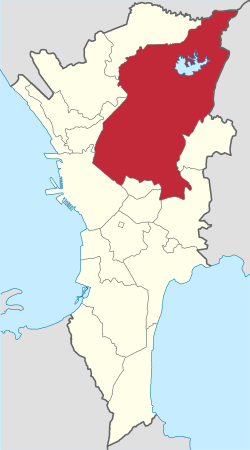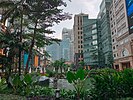Quezon City
Lungsod Quezon | |
|---|---|
|
| |
| Nickname: | |
| Anthem: Awit ng Lungsod Quezon (Anthem of Quezon City) | |
 Map of Metro Manila with Quezon City highlighted | |
Location within the Philippines | |
| Coordinates: 14°39′00″N 121°02′51″E / 14.65°N 121.0475°E | |
| Country | |
| Region | National Capital Region |
| Province | none |
| Districts | 1st to 6th districts |
| Incorporated (city) | October 12, 1939 |
| Highly urbanized city | December 22, 1979 |
| Named for | Manuel L. Quezon |
| Barangays | 142 (see Barangays) |
| Government | |
| • Type | Sangguniang Panlungsod |
| • Mayor | Joy Belmonte (SBP) |
| • Vice Mayor | Gian Sotto (SBP) |
| • Representatives | |
| • Council | Councilors |
| • Electorate | 1,403,895 voters (2022) |
| Area | |
• Total | 171.71 km2 (66.30 sq mi) |
| Elevation | 67 m (220 ft) |
| Highest elevation | 796 m (2,612 ft) |
| Lowest elevation | −2 m (−7 ft) |
| Population (2020 census)[6] | |
• Total | 2,960,048 |
| • Rank | 1st |
| • Density | 17,000/km2 (45,000/sq mi) |
| • Households | 738,724 |
| Demonym(s) | Taga-QC QCitizen |
| Economy | |
| • Income class | special city income class |
| • Poverty incidence | 1.80 |
| • Revenue | ₱ 24,024 million (2020) |
| • Assets | ₱ 441,279 million (2022) |
| • Expenditure | ₱ 23,068 million (2020) |
| • Liabilities | ₱ 29,660 million (2020) |
| Service provider | |
| • Electricity | Manila Electric Company (Meralco) |
| Time zone | UTC+8 (PST) |
| ZIP code | 1100 to 1138[8] |
| PSGC | |
| IDD : area code | +63 (0)2 |
| Native languages | Tagalog |
| Major religions | Catholic |
| Catholic diocese | Roman Catholic Diocese of Cubao, Roman Catholic Diocese of Novaliches |
| Patron saint | Our Lady of La Naval de Manila |
| Website | quezoncity |
Quezon City (UK: /ˈkeɪzɒn/, US: /ˈkeɪsɒn, -sɔːn, -soʊn/;[9][10][11][12] Filipino: Lungsod Quezon [luŋˈsod ˈkɛson] ), also known as the City of Quezon and Q.C. (read and pronounced in Filipino as Kyusi),[13][14][15] is the most populous city in the Philippines. According to the 2020 census, it has a population of 2,960,048 people. It was founded on October 12, 1939, and was named after Manuel L. Quezon, the second president of the Philippines.
The city was intended to be the national capital of the Philippines that would replace Manila, as the latter was suffering from overcrowding, lack of housing, poor sanitation, and traffic congestion. To create Quezon City, several barrios were carved out from the towns of Caloocan, Marikina, San Juan and Pasig, in addition to the eight vast estates the Philippine government purchased for this purpose. It was officially proclaimed the national capital on October 12, 1949, and several government departments and institutions moved out of Manila and settled into the new capital city. This necessitated the expansion of the city northward, carving out Novaliches from Caloocan which divided it into two non-contiguous parts. Several barrios were also taken from San Mateo and parts of Montalban. However, on June 24, 1976, Presidential Decree No. 940 was enacted, which reverted national capital status to Manila while the whole of Metro Manila was designated as the seat of government.[16][17] The city was also chosen as the regional center of Southern Tagalog, which was created in 1965, along with the provinces of Quezon and Aurora, the birthplace of Manuel L. Quezon; however, its status of regional center became ineffective when the region was divided into Calabarzon and Mimaropa, through the effect of Executive Order No. 103 in May 2002 under the presidency of Gloria Macapagal Arroyo, and Aurora was transferred to the authority of Central Luzon, with Southern Tagalog limited to being a cultural-geographic region.[18]
Quezon City is known for its culture, entertainment industry and media, and is aptly called the "City of Stars". Major broadcasting networks have their headquarters and studios in the city. It is also known for its commerce, education, research, technology, politics, tourism, art and sports. Several national government branches including the Batasang Pambansa Complex, the seat of House of Representatives of the Philippines, call the city home.
Quezon City is a planned city. It covers a total area of 161.11 square kilometers (62.20 sq mi),[5] making it the largest city in Metro Manila in terms of land area. It is politically subdivided into Six Congressional Districts, which represent the city in the Lower House of the Congress of the Philippines. The city has 142 barangays under the City Government. National government departments and agencies are mostly situated in the first National Government Center (NGC) in Diliman. and the second National Government Center in Batasan Hills, where the Lower House of the Philippine Congress is located. Most of the city's northern part lies at the foothills of the Sierra Madre mountain range, including the La Mesa Watershed Reservation, the largest watershed in Metro Manila and a designated protected area.
According to its 2023 estimated census, Quezon City had 3.1 million people in its boundaries, and 93.8 billion dollars in its GDP, and it is the only planned city in the National Capital Region of the Philippines.
- ^ San Diego, Bayani Jr. (July 21, 2012). "QC, 'City of Stars,' goes indie". Philippine Daily Inquirer. Archived from the original on April 19, 2019. Retrieved April 19, 2019.
- ^ Villamente, Jing (August 5, 2018). "Quezon City to host festival of Filipino films". The Manila Times. Archived from the original on April 19, 2019.
...a float parade and Grand Fans Day will be held in Quezon City which had been tagged the "City of Stars."
- ^ Quezon City | (DILG)
- ^ "2015 Census of Population, Report No. 3 – Population, Land Area, and Population Density" (PDF). Philippine Statistics Authority. Quezon City, Philippines. August 2016. ISSN 0117-1453. Archived (PDF) from the original on May 25, 2021. Retrieved July 16, 2021.
- ^ a b "Quezon City History". Quezon City Government. September 22, 2020. Retrieved July 25, 2021.
- ^ Census of Population (2020). "National Capital Region (NCR)". Total Population by Province, City, Municipality and Barangay. Philippine Statistics Authority. Retrieved July 8, 2021.
- ^ "PSA Releases the 2021 City and Municipal Level Poverty Estimates". Philippine Statistics Authority. April 2, 2024. Retrieved April 28, 2024.
- ^ "Quezon City ZIP Code", Philippine ZIP Codes Directory, archived from the original on September 13, 2008, retrieved September 12, 2008
- ^ "Quezon City". The American Heritage Dictionary of the English Language (5th ed.). HarperCollins. Retrieved April 18, 2019.
- ^ "Quezon City". Collins English Dictionary. HarperCollins. Retrieved April 18, 2019.
- ^ "Quezon City"[dead link] (US) and "Quezon City". Lexico UK English Dictionary. Oxford University Press. Archived from the original on August 6, 2020.
- ^ "Quezon City". Merriam-Webster.com Dictionary. Merriam-Webster. Retrieved April 18, 2019.
- ^ House Bill No. 3930 (2019), Tandang Sora Holiday Act of 2019 (PDF), House of Representatives of the Philippines, archived from the original (PDF) on January 20, 2022, retrieved September 30, 2023,
January 6 of every year is hereby declared as a special non-working holiday in the entire City of Quezon...
- ^ "Resolution 956 s. 2017: Approving the Comprehensive Land Use Plan of Quezon City, 2011-2025" (PDF). Housing and Land Use Regulatory Board. September 14, 2017. Archived from the original (PDF) on January 22, 2021. Retrieved February 17, 2021.
WHEREAS, the City of Quezon has mainstreamed...
- ^ "Part II". Quezon City at 75 Resurgent & Resilient. Erehwon Artworld Corporation for the Local Government of Quezon City through the Communications Coordination Center. 2014. pp. 131–133. ISBN 9789719566632.
- ^ "History of Quezon City Public Library" (PDF). November 21, 2006. Archived from the original on September 24, 2015. Retrieved July 25, 2014.
{{cite web}}: CS1 maint: unfit URL (link) - ^ Cite error: The named reference
GovPH-PD940was invoked but never defined (see the help page). - ^ Executive Order No. 103, s. 2002 (May 17, 2002), Dividing Region IV into Region IV-A and Region IV-B, Transferring the Province of Aurora to Region III and for Other Purposes, Official Gazette of the Republic of the Philippines, archived from the original on October 31, 2021, retrieved March 29, 2016,
SECTION 4. The Province of Aurora is hereby transferred to and shall form part of Region III.










